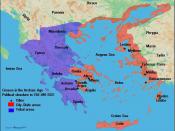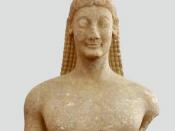The 'Golden Age' of Ancient Greece (referred to as the Classical Period) was the zenith of one of the most academic and prosperous civilisations of antiquity, all areas of humanistic pursuit thrived and excelled such as art, philosophy, literature, politics, theatre and technology. Art in particular became renowned for naturalistic interpretations of human form and through the masters of sculpture the legacy of Greece was assured. The emergence of this technical mastery grew out of what is known as the Archaic Period, and after reaching the climax of the Classical era greek culture disseminated during the Hellenistic Period. The Greeks perfected sculpture in all the main mediums of gold, ivory, wood, stone, terracotta, bronze and marble and the main forms of 'In the round', low relief and high relief [source: A History of Greek Art by F.B.Tarbell]. Sculptors depicted human-like gods or godlike humans often in the with the perfection embodied by Athletes of the Olympic Games.
The highest degree of control in technique captured an astounding realism, the most illustrious of all sculptors lived in the 'Golden Age' and those perceived to be the greatest include Myron of Athens, the well renowned Pheidias of Athens, Polykleitos of Argos, Praxiteles of Athens, Scopas of Paros and Lysippus of Sicyon [stated by F.B.Tarbell]. However what we know of artists and artworks are limited, no period of an art style ends suddenly at a specific date rather each flows from one to the other. What my essay will detail is aspects of the three most interesting periods in Greek sculpture (mentioned above), the subject of the sculptures from these periods and the six of the finest Greek sculptors (mentioned above).
The Archaic Period is noted as being when naturalism began to substantially emerge in greek sculpture and when sculpture emerged as a...



Solid
great and thorough job. good history of Greek sculpture.
0 out of 0 people found this comment useful.